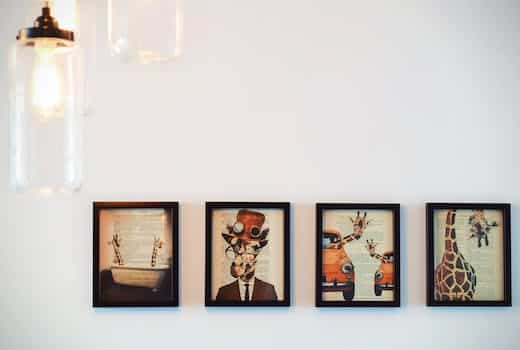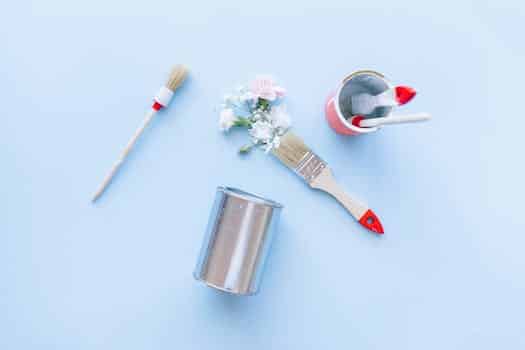Wall painting is an easy and affordable way to give your home a fresh new look. With a little creativity and some paint, you can transform your walls into stunning works of art. In this article, we’ll share 10 DIY wall painting ideas that will inspire you to create a beautiful and unique space in your home.
- 1. Introduction
- 2. Basic painting techniques
- 2.1. Choosing the right paint
- 2.2. Preparing the walls
- 2.3. Using painter’s tape
- 2.4. Painting techniques
- 2.5. Clean-up tips
- 3. DIY wall painting ideas
- 3.1. Stripes and geometric shapes
- 3.2. Ombre effect
- 3.3. Stenciling
- 3.4. Polka dots
- 3.5. Wallpaper accent
1. Introduction
Painting your walls is a quick and affordable way to give your home a fresh new look. With a little creativity and some DIY spirit, you can transform your walls from drab to fab. In this article, we’ll share 10 DIY wall painting ideas that will inspire you to take on your next home improvement project. Whether you’re a seasoned pro or a beginner, these ideas are sure to spark your creativity and help you create a beautiful and unique space.
1.1. Why DIY wall painting?
DIY wall painting is a great way to transform the look and feel of your home without breaking the bank. Not only is it a cost-effective way to update your decor, but it also allows you to express your creativity and personal style. With a little bit of time and effort, you can easily create a unique and beautiful space that reflects your personality. Whether you’re a seasoned DIYer or just starting out, there are plenty of wall painting ideas that can help you achieve the look you want. In this article, we’ll share 10 DIY wall painting ideas that are sure to inspire you.
1.2. Benefits of painting your walls
Painting your walls can bring a whole new life to your home. Not only does it give your walls a fresh and clean look, but it can also enhance the overall aesthetic of your space. Painting your walls can also be a cost-effective way to transform your home without having to undergo a full renovation. In addition, painting your walls can also provide a layer of protection against everyday wear and tear. With so many colors and finishes to choose from, the possibilities for transforming your space are endless.
1.3. Tools and materials needed
Before starting any DIY wall painting project, it is important to gather all the necessary tools and materials. Here are some of the basic items you will need:
– Paint brushes (various sizes)
– Paint rollers (with covers appropriate for your wall type)
– Paint tray
– Painter’s tape
– Drop cloths or old sheets to protect floors and furniture
– Sandpaper (if needed)
Additionally, you will need to choose the paint colors and finishes you want to use. Consider the overall color scheme of the room and any accents or decor you want to highlight. With the right tools and materials, you can transform any wall into a work of art!
2. Basic painting techniques
Before beginning any DIY wall painting project, it’s important to have a good grasp of basic painting techniques. Here are some tips to help you get started:
1. Prep your walls before painting. This includes cleaning the surface, repairing any holes or cracks, and taping off areas you don’t want painted.
2. Use quality paint and tools. Invest in a good paintbrush and roller to ensure a smooth, even finish.
3. Use a primer. This will help the paint adhere better to the wall and provide a more even finish.
4. Apply multiple thin coats of paint instead of one thick coat. This allows each layer to dry properly and ensures a more professional finish.
5. Use a paint edger tool when painting around corners or edges to achieve a clean, crisp line.
By following these basic painting techniques, you’ll be able to tackle any DIY wall painting project with confidence and achieve professional-looking results.
2.1. Choosing the right paint
Choosing the right paint for your DIY wall painting project is crucial for achieving the desired results. There are different types of paint available in the market, each with its own unique set of properties. The most commonly used types of paint are latex and oil-based paints. Latex paint is water-based and is easy to clean up with soap and water. It dries quickly and has a low odor. Oil-based paint, on the other hand, is more durable and provides a smoother finish. It takes longer to dry and requires mineral spirits for clean-up.
When choosing a paint color, consider the mood you want to create in the room. Lighter colors can make a room feel more spacious, while darker colors can create a cozy and intimate atmosphere. You can also experiment with different finishes, such as matte or glossy, to add texture and depth to your walls.
2.2. Preparing the walls
Before you start painting your walls, it’s important to prepare them properly. This means cleaning them thoroughly and repairing any cracks or holes. Use a putty knife to fill in any gaps, and sand the surface smooth. You should also prime the walls before painting to ensure a smooth and even finish. Taking the time to prepare your walls will help your paint job look professional and last longer.
2.3. Using painter’s tape
Using painter’s tape is a basic painting technique that can help you achieve clean and precise lines. It’s especially useful when you’re painting stripes, geometric shapes, or other patterns. Simply apply the tape to the areas where you don’t want paint to go, and then paint over the rest of the wall. Once the paint is dry, carefully remove the tape to reveal your crisp lines. Just be sure to remove the tape while the paint is still slightly wet to avoid peeling off any paint with the tape.
2.4. Painting techniques
Basic painting techniques are essential to achieve a professional-looking paint job. Here are some techniques to keep in mind when painting your walls:
1. Use a high-quality paint brush or roller to ensure even coverage.
2. Use a primer before painting to help the paint adhere better and last longer.
3. Paint in a ‘W’ shape to ensure that the paint is evenly distributed.
4. Start painting from the top of the wall and work your way down.
5. Use long strokes when painting to avoid leaving brush or roller marks.
By following these basic painting techniques, you can achieve a beautiful and long-lasting paint job for your home.
2.5. Clean-up tips
Before you start painting, it’s important to prepare your walls properly. This includes cleaning the surface to remove any dirt or debris. Use a damp cloth or sponge to wipe down the walls and let them dry completely before you begin. Additionally, make sure to cover any furniture or flooring with drop cloths or plastic sheeting to protect them from paint drips or splatters.
3. DIY wall painting ideas
If you’re looking to add some personality and style to your home, painting your walls is a great way to do it. But why settle for plain old solid colors when you can get creative with DIY wall painting ideas? Here are 10 ideas to inspire you:
1. Ombre walls: Blend two or more colors together to create a gradient effect that fades from light to dark (or vice versa).
2. Geometric shapes: Use painter’s tape to create a variety of shapes and patterns, such as triangles, diamonds, or chevrons.
3. Stenciled designs: Use stencils to create repeating patterns or detailed designs on your walls.
4. Stripes: Vertical, horizontal, or diagonal stripes can add a bold, graphic look to any room.
5. Chalkboard walls: Paint a wall (or part of a wall) with chalkboard paint so you can write messages, draw pictures, or keep a to-do list.
6. Metallic accents: Add a touch of glamour with metallic paint or a metallic accent wall.
7. Ombre stripes: Combine the ombre and stripe trends by painting a wall with stripes that fade from light to dark.
8. Ombré chevron: This is a fun twist on the ombre trend. Use painter’s tape to create chevron stripes, then blend the colors together.
9. Polka dots: Use a round sponge or stencil to create a playful polka dot pattern on your walls.
10. Gradient hexagons: Create a honeycomb pattern on your walls by using hexagon stencils and blending colors together for a gradient effect.
3.1. Stripes and geometric shapes
One popular trend in DIY wall painting is the use of stripes and geometric shapes. These designs can add a modern and stylish touch to any room in your home. To achieve this look, you can use painter’s tape to create clean, straight lines and angles. Choose colors that complement each other and the overall aesthetic of your space. You can also experiment with different widths and shapes to create a unique and personalized design. With a little patience and creativity, you can transform a plain wall into a work of art.
3.2. Ombre effect
One trendy technique to add some visual interest to your walls is by creating an ombre effect. This effect involves gradually blending one color into another, creating a subtle gradient. To achieve this look, start by selecting two or more shades of the same color. Then, paint the darkest shade at the bottom of the wall and gradually lighten the color as you move up. You can use a sponge or a dry brush to blend the colors together. The result is a beautiful, soothing effect that adds depth and dimension to any room.
3.3. Stenciling
Stenciling is a great way to add some personality and texture to your walls without breaking the bank. There are countless stencils available in a variety of patterns and styles, making it easy to find one that suits your taste. Simply tape the stencil to the wall and use a roller or brush to apply the paint. It’s a fun and easy DIY project that can completely transform a room.
3.4. Polka dots
Polka dots are a fun and playful way to add some personality to your walls. To achieve this look, start by painting your walls a solid color. Then, using a round sponge or stencil, apply dots in a contrasting color to create a pattern. You can create a uniform pattern or mix up the size and placement of the dots for a more eclectic look. This DIY project is perfect for a child’s bedroom or a playful accent wall in a living room or home office.
3.5. Wallpaper accent
If you’re looking for an easy way to add some interest and texture to your walls without committing to a full paint job, consider creating a wallpaper accent. Simply choose a bold or patterned wallpaper and apply it to a single wall in the room. This will create a focal point and add depth to the space. Plus, if you ever tire of the look, it’s easy to remove and replace with a new wallpaper pattern.
Conclusion
In conclusion, these 10 DIY wall painting ideas can completely transform the look and feel of your home. With a little creativity and effort, you can add a personal touch to your walls and create a space that truly reflects your style and personality. Whether you opt for bold colors, geometric patterns, or subtle textures, these painting techniques are sure to breathe new life into any room.






These 10 innovative and imaginative DIY home decor ideas from [object Object] provide a refreshing approach to enhancing ones living…